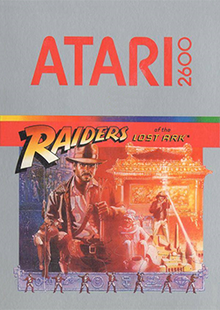
E.T. the Extra-Terrestrial is a 1982 adventure video game developed and published by Atari, Inc. for the Atari 2600 and based on the film of the same name. The game's objective is to guide the eponymous character through various screens to collect three pieces of an interplanetary telephone that will allow him to contact his home planet.

Kaboom! is an action video game published in 1981 by Activision for the Atari 2600. The gameplay was based on the Atari arcade video game Avalanche (1978), with the game now involving a Mad Bomber who drops bombs instead of falling rocks. Kaboom! was programmed by Larry Kaplan with David Crane coding the graphics for the buckets and Mad Bomber. It was the last game designed by Kaplan for Activision, who left the company shortly after the release of the game. The game was later ported by Paul Wilson for the Atari 5200 system.

Joust is an action game developed by Williams Electronics and released in arcades in 1982. While not the first two-player cooperative video game, Joust's success and polished implementation popularized the concept. Players assume the role of knights armed with lances and mounted on large birds, who must fly around the screen and defeat enemy knights riding buzzards.

Adventure is a video game developed by Warren Robinett for the Atari Video Computer System and released in 1980 by Atari, Inc. The player controls a square avatar whose quest is to explore an open-ended environment to find a magical chalice and return it to the golden castle. The game world is populated by roaming enemies: three dragons that can eat the avatar and a bat that randomly steals and hides items around the game world. Adventure introduced new elements to console games, including enemies that continue to move when offscreen.

Pitfall! is a video game developed by David Crane for the Atari 2600 and released in 1982 by Activision. The player controls Pitfall Harry, who has a time limit of 20 minutes to seek treasure in a jungle. The game world is populated by enemies and hazards that variously cause the player to lose lives or points.

Howard Scott Warshaw, also known as HSW, is an American psychotherapist and former game designer. He worked at Atari, Inc. in the early 1980s, where he designed and programmed the Atari 2600 games Yars' Revenge, Raiders of the Lost Ark, and E.T. the Extra-Terrestrial.
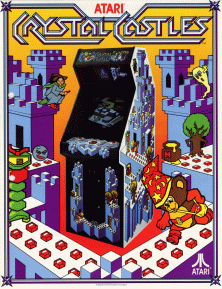
Crystal Castles is an arcade video game released by Atari, Inc. in 1983. The player controls Bentley Bear who has to collect gems located throughout trimetric-projected rendered castles while avoiding enemies, some of whom are after the gems as well.
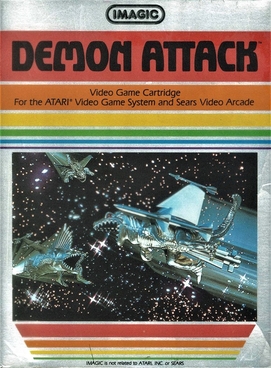
Demon Attack is a fixed shooter video game created by Rob Fulop for the Atari 2600 and published by Imagic in 1982. The game involves the player controlling a laser cannon from the surface of a planet, shooting winged demons that fly down and attack the player in different sets of patterns.

Swordquest is a series of video games originally produced by Atari, Inc. in the 1980s as part of a contest, consisting of three finished games, Earthworld, Fireworld and Waterworld, and a planned fourth game, Airworld.

Cyberball is a video game released in arcades in 1988 by Atari Games. The game is a 7-man American football using robotic avatars of different speeds, sizes, and skill sets set in the year 2022. Originally released for arcades, Cyberball was ported to several home consoles and computers.

Haunted House is a 1982 adventure video game programmed by James Andreasen for the Atari Video Computer System and published by Atari. The player controls an avatar shaped like a pair of eyes who explores a mansion seeking out parts of an urn to return to the entrance. The game world is populated by roaming enemies including vampire bats, tarantulas, and a ghost. Haunted House was among the first games to use player-controlled scrolling between large portions of the visual space.

Adventure Island 3 is a side-scrolling platform game published by Hudson Soft that was originally released for the Nintendo Entertainment System in 1992. It is the third game in the Adventure Island released for the NES, following Adventure Island II. Unlike the first two games in the series, the NES version was never released in Europe. A portable version was also released for the Game Boy in 1993 titled Takahashi Meijin no Bouken Jima III, renamed to Adventure Island II: Aliens in Paradise outside of Japan.

Atlantis is a fixed shooter video game released by Imagic in July 1982 for the Atari 2600. It was written by Dennis Koble who also wrote Trick Shot, Solar Storm, and Shootin' Gallery for Imagic. Atlantis was ported to the Atari 8-bit computers, VIC-20, Intellivision, and Magnavox Odyssey 2. The game was inspired by Taito's 1981 Colony 7 arcade game.

Space Dungeon is a multidirectional shooter released as an arcade video game by Taito in 1981. Designed and programmed by Rex Battenberg, it was available both as a conversion kit and full arcade cabinet. An Atari 5200 port was published in 1983.

Mickey Mousecapade, released in Japan as Mickey Mouse: Adventures in Wonderland, is a platform video game based on Disney's Mickey Mouse franchise. It was developed and published by Hudson Soft originally in 1987 for the Family Computer in Japan. Capcom published the game for the Nintendo Entertainment System in the United States in 1988.
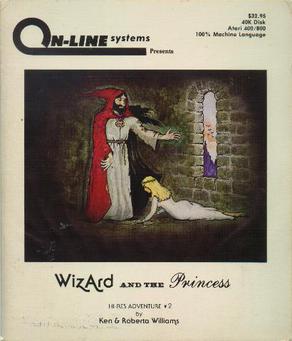
Wizard and the Princess is a graphic adventure game written for the Apple II and published in 1980 by On-Line Systems. It is the second installment in the Hi-Res Adventures series after Mystery House. Unlike its predecessor, which featured monochrome drawings, Wizard and the Princess introduced color graphics. Ports for the Atari 8-bit computers and Commodore 64 were released in 1982 and 1984 respectively. The 1982 self-booting disk version for IBM PC compatibles was renamed Adventure in Serenia.

Dominos is a one, two or four-player video action game packaged in its own distinctively styled upright cabinet that rest directly on the floor.

Indiana Jones and the Temple of Doom is an action game released in 1988 for the Nintendo Entertainment System. The game is based on the arcade game and film of the same name. The resulting product differed from the arcade version in several aspects, but kept the same underlying premise and style.

Superman is a video game programmed by John Dunn for the Atari Video Computer System and released in 1979 by Atari, Inc. The player controls Superman, whose quest is to explore an open-ended environment to find three pieces of a bridge that was destroyed by Lex Luthor, capture Luthor and his criminal gang, and return to the Daily Planet building. The game world is populated by antagonists such as a helicopter that re-arranges the bridge pieces and roving kryptonite satellites that cause Superman to revert into Clark Kent.
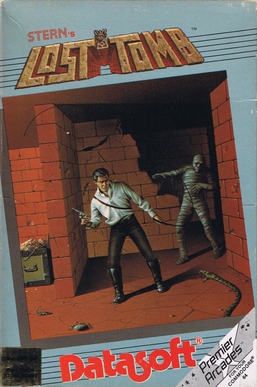
Lost Tomb is an overhead-view twin-stick shooter written by Dan Lee and released as an arcade video game by Stern Electronics in 1982. Armed with a gun and whip, the player uses dual joysticks to explore the chambers of a South American pyramid looking for treasure and fighting mummies, spiders, and scorpions. The game was Stern's first arcade conversion kit and was intended for use with earlier machines from the company.
